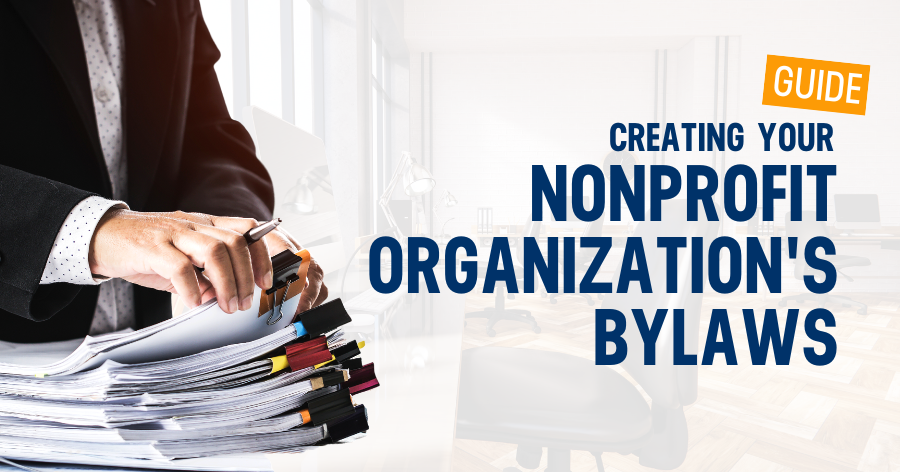
Nonprofit organizations should spend their passion, time and creative energy on working hard to strengthen and enrich our communities. Not wasting time trying to answer questions like “how do we remove a board member?”, “how often shall we meet as a board?” or even, “who’s responsibility is this?” That’s why we’ve created a simple guide to creating your nonprofit organization bylaws. So that you can focus on what matters while operating at a legal, professional and trusted level.
Also read:
- The Challenges Of Nonprofit Boards
- 12 Must-Read Nonprofit Governance Books
- The Ultimate Guide to the Nonprofit Strategic Planning Process
What are nonprofit bylaws?
Nonprofit bylaws are the primary governing document of your organization. They contain only general operational rules of the organization and the general duties of officers and directors. Overall, they expand over various categories such as membership, conventions for the board and member meetings. Including the annual general meeting (AGM).
Although nonprofit bylaws dictate how your organization runs, the bylaws should only supplement your government’s already defined rules. That’s why it’s vital to ensure you comply. As some cities will have different or further regulations for nonprofits, you need to know when creating your bylaws.
What is the purpose of bylaws for nonprofits?
The purpose of bylaws for your nonprofit organization is to ensure you can guide the board’s actions and decisions in a meaningful and valuable way. Bylaws are usually put in place to protect the nonprofit organization’s future from potential issues. Achieved by setting clear guidelines and rules about authority rights and expectations amongst the board and employees. However, if your board of directors fails to follow any of the bylaws, they will be legally liable for breaching their duty to the organization.
Also read: 5 Critical Reasons To Start The NPO Bylaw Review Process Today
How to write bylaws for a nonprofit organization: Best Practices
1. Consult an expert
Bylaws are where your organization’s governance begins. That’s why it’s crucial to consult an expert that can guide you away from creating and dealing with governance violations. More so, by consulting an expert, you can ensure that every member is fully aware of the organization’s bylaws, which creates higher levels of results in the shortest amount of time.
Start increasing your organization’s effectiveness in the safe hands of AMC’s governance and strategic planning specialists. Create or review bylaws and gain the invaluable training your organization needs through in-person sessions, virtual instructor-led training or our easy-to-access e-learning platform: NPO Academy.
2. Learn the difference between “shall” and “may”
At first glance, the difference seems inconsequential, but it’s important to note that when writing your bylaws, there is a distinct difference between the words “shall and “may.”
- Use the word “shall” when referring to something board members are required to complete.
- Use the word “may” when the task is optional.
3. Use an online by-law builder
Are you struggling to create a concise set of nonprofit bylaws as required under the Canada Not-for-Profit Corporations Act? Luckily there is an easy-to-use and free online tool provided by the government of Canada: the Bylaw builder: not-for-profit corporations.
Once you have completed all of the steps and have chosen your by-law provisions, the By-law Builder will generate your customized by-laws as a temporary webpage. You must then copy and paste this content into the word processing software of your choice in order to save it or edit it.
Government of Canada: By-law builder: not-for-profit corporations*
Look at similar organizations’ bylaws for reference
It’s always helpful to look at several similar organizations to gather a range of ideas, which you can then use to create a rough guide for your first draft. Please don’t copy another organization’s bylaws word-for-word but change the organization’s name. Your bylaws are unique to your operation – so only use this technique as a starting point.
Your checklist for creating nonprofit bylaws
Below is a detailed checklist for creating your bylaws, be sure to download the infographic to serve as a helpful reference!
1. Name
You should indicate the name of your organization in your bylaws as “this organization shall be known as [Organization Name]” or, if you prefer, “the official name of this organization is [Organization Name].” If you have more than one name, shortened or abbreviated, you can also mention that you go by these names.
2. Purpose
Next, clearly define the purpose of your organization to help you remain focused. You need to be specific when outlining the primary purpose of your organization. For instance, is it political? Social or something else entirely? Do you focus on multiple issues or just one? Many organizations opt to include their vision and mission statements in this section.
3. Membership
The membership section is a chance to explain what your members’ rights actually are, their limitations and any requirements you may have to retain their membership, including attendance, fees or particular circumstances. If you’re considering or allowing honorary memberships, you need to include the specific requirements here.
4. Meeting guidelines
You must state the frequency at which meetings will occur; for instance, “there will be regular meetings on the first Wednesday of every month.” In this section, you should also define when you’re planning to hold your annual meeting. These guidelines should also state what the board expects to discuss in each meeting; for example, “in our annual meetings, directors meet to hear committee reports.”
5. Board structure
This section needs to detail how many members are on your board, alongside how they become these members and what position they hold.
6. Committees
Your bylaws must state all of your standing committees, such as finance, membership, auditing, social and so on. It must include details of how many members are on each committee, alongside their responsibilities. Next, you must state who members should submit their resignations to and who will fill these vacancies.
7. Conflict of interest policy
This policy is a general statement of the legal principles that apply. It must be readily available to society participants. While everyone in a society is subject to these duties, some people, like directors and officers, are subject to higher duties, such as those set out in the [Standards of Conduct Act.]
Also read: Addressing Conflict of Interest in Not-For-Profit Organizations.
8. Dissolution of the organization
Dissolution is the process of legally terminating your organization. Your organization will only dissolve when Corporations Canada issues a Certificate of Dissolution. However, there are two ways to handle dissolutions depending on whether the organization has property and liabilities – or not. The exception is bankrupt organizations, which can only apply to dissolve three years after the trustee or interim receiver has been discharged**.
Nonprofit bylaws FAQ
Do you still have unanswered questions from the previous section? You can find answers to some of the most common questions regarding nonprofit bylaws below.
What to do when nonprofit bylaws are not followed?
Every individual employee or board member in your organization is legally responsible and accountable for following your bylaws. If you’re unsure if there is a non-compliance, you can always first double-check your bylaws. Once confirmed, you must contact the employee or board member concerned to determine whether this was a mistake or purposeful. You can resolve most cases at this stage, but if not, it’s advisable to seek the correct legal help to resolve the matter. If you’re a part of a larger organization, you might need to take the case to higher authorities before taking any action.
How often should a nonprofit review its bylaws?
Although there is no official standard for reviewing your bylaws, every two years is the general recommendation to ensure they accurately reflect the organization’s inner workings and remain relevant to what you’re trying to achieve.
What about changing or amending your bylaws?
You can amend your bylaws once they have been created. However, the process is different depending on what changes you need to make. Read on below to discover what the Government of Canada suggests for either ordinary amendments or special amendments, also referred to as resolutions.
Ordinary resolutions
Step 1 – The board of directors initiates a change to a general by-law. The effective date of this change is the date it is approved by the directors.
Step 2 – The by-law change is placed on the agenda for the next meeting of members.
Step 3 – Members confirm the by-law change (or they amend it and then confirm it) by ordinary resolution.
Step 4 – If the members reject the by-law adopted by the directors, the by-law change ceases to have effect on the date it is rejected by the members. Alternatively, if the directors fail to submit the by-law change to the members at the next members meeting, the by-law change ceases to have effect on the date of the members meeting at which it should have been submitted to the members. In such cases, future by-law changes that have substantially the same effect as the one rejected or not submitted will not become effective on approval of the directors. They only become come into effect when approved by the members.
Step 5 – Within 12 months of the confirmation of the by-law changes by the members, a copy of the amended by-laws must be sent to Corporations Canada.
Government of Canada | Not-for-profit corporation by-laws
Special resolutions
Step 1 – Initiate a change to a special by-law by a member proposal or by the board of directors.
Step 2 – Members approve the change (or they amend it and then confirm it) by special resolution. If the subject matter of the special by-law amendment addresses exchanging, reclassifying or cancelling all or part of the memberships of a particular class, approval of the special by-law amendment will require a separate class vote (refer to section 199(1) of the NFP Act). In a separate class vote, members of a class who do not otherwise have the right to vote are permitted to vote separately as a class (see Rights and responsibilities of members).
Step 3 – The by-law change takes effect, as approved, on the date of the member approval.
Step 4 – Within 12 months of the confirmation of the by-law changes by the members, a copy of the amended by-laws must be sent to Corporations Canada.
Government of Canada | Not-for-profit corporation by-laws
Disclaimer: However, the above article is provided as a helpful starting point for creating your nonprofit bylaws. AMC can not guarantee its accuracy. The reader is encouraged to do their own research to verify the information with necessary governing authorities when necessary/important to the reader.
Do you review your bylaws every two years?
Organizations engage AMC for Nonprofit Bylaw Reviews because we’re nonprofit specialists, having worked with over 450 organizations across Canada since 1987.
We update the bylaws of multiple nonprofits every year, so you can be sure that we’re up to date on the latest requirements, regulations and evolutions when it comes to bylaws.
Contact us today and ensure your organization operates at a legal, professional and trusted level.

